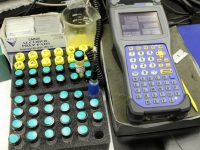The Value Of Oil Analysis Testing Any business that relies on heavy machinery to carry out their daily tasks also relies on things like oil analysis testing to actively monitor the condition of those machines. There are many industries that have to have some pretty expensive pieces of machinery running around the clock, and that…
Read more
6 Steps to Update Your Lubrication Program
6 Steps to Update Your Lubrication Program In today’s culture of looking for high returns on investments, there are not many that can compare to a comprehensive lubrication program. Tremendous financial savings can be enjoyed by eliminating poor lubrication practices from an organization. Numerous financial losses are attributable to poor and inadequate lubrication programs and…
Read more
Calculating Remaining Useful Life

Calculating Remaining Useful Life The field of Predictive Maintenance (PdM) is providing a strong and growing set of tools, techniques and technologies to optimize operations, maintenance and renewal processes of industrial assets. Condition monitoring techniques, in particular, yield valuable insight into the state of health of industrial equipment, providing clues and hints on expected future…
Read more
FTIR Enhancement of Turbine Oils
FTIR Enhancement of Turbine Oils Earlier this year, TestOil modified our FTIR analysis for turbine oil and began reporting new, enhanced parameters. We improved the data interpretation to generate these new parameters which provide our customers a more detailed oil analysis of the health of their turbine oil. New parameters include: Thermal Event Acid - A degradation mechanism of the…
Read more
Oil Analysis Testing: On-site vs. Off-site
Oil Analysis Testing: On-site vs. Off-site The first and often the obvious option is to have an on-site oil analysis lab to process all oil samples collected. There are many pros to this option. Turnaround time for results can be controlled in house. There is no dependence on an outside resource. Testing packages can be altered easily,…
Read more
Why Does Used Oil Need to be Analyzed?
Why Analyze Used Lubricants Selecting the proper lubricant, along with careful maintenance of that lubricant, is essential to ensure adequate protection to any component. Proper lubrication is defined as the correct amount of the correct lubricant at the correct time. Maintaining a lubricant means ensuring that it is the correct viscosity and has the necessary…
Read more

